Fixed (among other few things): https://at-horns.eu/release/ath-4.8.3-beta.zipI'm getting the same error that a couple of people are also getting.
Just replace the exe file.
Problem is, my compression driver cannot play an LR4 at 1k, it is dropping of too early. At 1k, it looks better:
View attachment 1042013
I found out yesterday that, if one accepts some more spill in vertical axis, which is in part annihilated by crossover nulls, the waveguide shows very good curves, both SP, DI and PIR, when crossed with LR4 at 800 Hz. I will see if it is reasonable to try push the CDX1-1747 there, but from my previous experience, it is falling like a rock below 1000 Hz so that it is not even sure if a boost could at all change its behaviour.
Is there a budget friendly 1-inch exit compression driver which can be crossed LR4 at 800 Hz?
Here is why I ask:
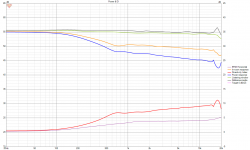
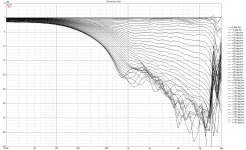
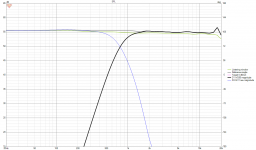
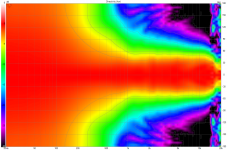
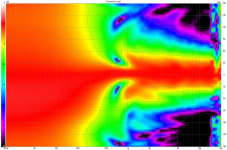
I would like to hear advice. On the sheet, it does look like a spectacular result for such a small waveguide, fishing well in the domain of much bigger, or, as with cardiod, lesss efficient and technically more complex speakers. It comes as mere surprise, a coincidence, and I wonder if instead of optimizing the waveguide for a crossover between 1-1.5 k, I should take this as a hint and see if this much lower crossover point was possible too. Will a DFM-2535R00 work this low?





I would like to hear advice. On the sheet, it does look like a spectacular result for such a small waveguide, fishing well in the domain of much bigger, or, as with cardiod, lesss efficient and technically more complex speakers. It comes as mere surprise, a coincidence, and I wonder if instead of optimizing the waveguide for a crossover between 1-1.5 k, I should take this as a hint and see if this much lower crossover point was possible too. Will a DFM-2535R00 work this low?
There would be no replacement for a bigger waveguide if you wanted a higher DI maintained to lower frequencies. That's not really comparable to what you have. (That doesn't mean I don't like the results.)
Last edited:
I suppose it depend on your SPL/distortion requirements for the system. I myself are betting one the MBS 5530ND which has a stated lowest use = 1k. All others 1" I have seen are a bit higher. The spec sheet for the DFM-2535 says "Test Spectrum Bandwidth 1.5K - 15K Hz" so I would intepret that as 1,5k really...? Hard to say without proper data. Its a shame that these "proffesional" driver suppliers cant provide relevant product data.
But I have no experience in the field as I'm venturing into my first horn/CD project.
//
But I have no experience in the field as I'm venturing into my first horn/CD project.
//
The rising DI, which implicates a lower DI, when a wider pattern in the upper octaves is a target, is intentional. The significantly higher DI, as to Earl Geddes teachings, is not the target with this waveguide, which is going after a slightly wider pattern.
The question was rather concerned with trade-offs of a lower crossover point, other than keeping DI high. If this simulation holds true, it promises a gradually rising DI and pattern control beyond 1k, if, and here I don’t know enough, there is not problems with a crossover point that low. The said Tymphany compression driver for example begins to decay slower in this frequency range, which does not come as a surprise, but distortion seems stillokay. Which consideration apart from DI speak against a XO of 800 Hz here?
The question was rather concerned with trade-offs of a lower crossover point, other than keeping DI high. If this simulation holds true, it promises a gradually rising DI and pattern control beyond 1k, if, and here I don’t know enough, there is not problems with a crossover point that low. The said Tymphany compression driver for example begins to decay slower in this frequency range, which does not come as a surprise, but distortion seems stillokay. Which consideration apart from DI speak against a XO of 800 Hz here?
I understand that the above question is not perhaps about driver but rather the WG. Still, to adress sheeples question about a lower XO point I would like the expertise opinion on what one could expect between the BMS and the Peerless...
https://audioxpress.com/article/peerless-by-tymphany-dfm-2535r00-08-compression-driver
https://audioxpress.com/article/test-bench-the-bms-1-5530nd-high-efficiency-compression-driver
200€ to be saved here 🙂
//
https://audioxpress.com/article/peerless-by-tymphany-dfm-2535r00-08-compression-driver
https://audioxpress.com/article/test-bench-the-bms-1-5530nd-high-efficiency-compression-driver
200€ to be saved here 🙂
//
That's fine, I had a similar target in mind with some of my designs. It's just that you wrote "it does look like a spectacular result for such a small waveguide, fishing well in the domain of much bigger", which is really not what's happening. I only wanted to make that clear.The rising DI, which implicates a lower DI, when a wider pattern in the upper octaves is a target, is intentional. The significantly higher DI, as to Earl Geddes teachings, is not the target with this waveguide, which is going after a slightly wider pattern.
Last edited:
The DFM-2535R00 was measured on ST260 here:
https://www.diyaudio.com/community/...-design-the-easy-way-ath4.338806/post-6737942
It seems more than capable but I can't comment on the distortion. I haven't looked at the driver in that detail yet. It's all about SPL.
https://www.diyaudio.com/community/...-design-the-easy-way-ath4.338806/post-6737942
It seems more than capable but I can't comment on the distortion. I haven't looked at the driver in that detail yet. It's all about SPL.
Aragorus measured BMS 4550 in a WG with ESP recently, obviously after an EQ but it looked incredible:
https://www.diyaudio.com/community/attachments/bms4550_4vaneplug-png.1004919/
Perhaps he could share some more detail.
https://www.diyaudio.com/community/attachments/bms4550_4vaneplug-png.1004919/
Perhaps he could share some more detail.
From the impedance plot of the BMS you can see the fs is between 1 and 2k. This is also what is the case with CDX1-1747 and which results in a rapidly falling SPL below 1k on the one hand, in a high decay rate slightly below resonant frequency on the other. The latter being a reason why I had decided against crossing it lower. It is spec-ed as 1k crossover for HiFi use too.I understand that the above question is not perhaps about driver but rather the WG. Still, to adress sheeples question about a lower XO point I would like the expertise opinion on what one could expect between the BMS and the Peerless...
https://audioxpress.com/article/peerless-by-tymphany-dfm-2535r00-08-compression-driver
https://audioxpress.com/article/test-bench-the-bms-1-5530nd-high-efficiency-compression-driver
200€ to be saved here 🙂
//
Last edited:
Looking at the Celestion product page.... the right vertical scale... Impedance (dB) and why axis go to 70... it's all just to obfuscate... sad really... https://celestion.com/product/cdx1-1747/
The whole "professional industry" is really a shamble - nothing professional about it... measurements uncertain, half crap i'd say... look at Purify - just in an other league...
//
The whole "professional industry" is really a shamble - nothing professional about it... measurements uncertain, half crap i'd say... look at Purify - just in an other league...
//
Purifi serves very different needs and applications, all their data is a waste with basic PA speakers, which have mass of linear distortion to begin with.
I'd like to re-reference the paper that we did at B&C. In that paper we looked at what factors did subjects perceive the most. Nonlinear distortion was not really even a factor. It was mostly frequency response. In home use the manufacturers data is going to be extremely conservative because pros like to push everything to the limits. A pro CD is overkill for home use, but does yield a sufficient headroom such that distortion and LF excursion are never really an issue. A DE250 can easily do 800 Hz at ear splitting levels in a home situation. But pros will blow them up regularly.I can't comment on the distortion.
I know a DE250 can do 800 Hz, I'm only reluctant to say that the smaller DFM-2535R00 can do it as well without some kind of checking - it has only a 1.4" diaphragm and based on the lumped element models I tried there was always a frequency below which the excursion rised very rapidly. Can a DFM-2535R00 do 800 Hz? That was the particular question. Given your response, it probably can.
It has also a bigger version (1.75" diaphragm + 3x the nominal x-max): https://en.toutlehautparleur.com/lo...rless-dfm-2544r00-08-8-ohm-1-inch-throat.html
It has also a bigger version (1.75" diaphragm + 3x the nominal x-max): https://en.toutlehautparleur.com/lo...rless-dfm-2544r00-08-8-ohm-1-inch-throat.html
Last edited:
That, it can.A DE250 can easily do 800 Hz at ear splitting levels
Honestly though, I am at a loss to understand why one would ever compromise on the CD. It's such a critical part of the equation. (But I have seen lots of cases of "overkill" using this logic.) Like the plots that I commented on ( two diaphragms ...) I can only say that the driver shown there was either broken of intolerably poor design. I am way out of touch with driver models and prices, but I know that when I was building speakers the drivers were not expensive enough to even worry about - given all the other costs, the time, and the end result.I know a DE250 can do 800 Hz, I'm only reluctant to say that the smaller DFM-2535R00 can do it as well without some kind of checking - it has only a 1.4" diaphragm and based on the lumped element models I tried there was always a frequency below which the excursion rised very rapidly. Can a DFM-2535R00 do 800 Hz? That was the particular question. Given your response, it probably can.
It has also a bigger version (1.75" diaphragm + 3x the nominal x-max): https://en.toutlehautparleur.com/lo...rless-dfm-2544r00-08-8-ohm-1-inch-throat.html
Honestly, I found the DE250 and DE500 (for different applications) to be almost unexcelled in there performance. And I looked at a lot of drivers. Including hi-end TADs.
It certainly can, but the DE250's Xmax is probably closer to .5mm than .1mm, so would have more than 10dB more output potential before the diaphragm crashes into the phase plug, even if the same Sd. Given the 1.4" diaphragm, the potential output difference is probably well over 12 dB, less than half as ear splitting 😉 .I know a DE250 can do 800 Hz, I'm only reluctant to say that the smaller DFM-2535R00 can do it as well without some kind of checking - it has only a 1.4" diaphragm and based on the lumped element models I tried there was always a frequency below which the excursion rised very rapidly. Can a DFM-2535R00 do 800 Hz? That was the particular question. Given your response, it probably can.
Xmax of 0.3mm still seems a bit on the low excursion side for a 1.75" diaphragm, but would explain it's response extending past 30kHz.It has also a bigger version (1.75" diaphragm + 3x the nominal x-max): https://en.toutlehautparleur.com/lo...rless-dfm-2544r00-08-8-ohm-1-inch-throat.html
Nice to see compression drivers with useful specifications!
Art
- Home
- Loudspeakers
- Multi-Way
- Acoustic Horn Design – The Easy Way (Ath4)